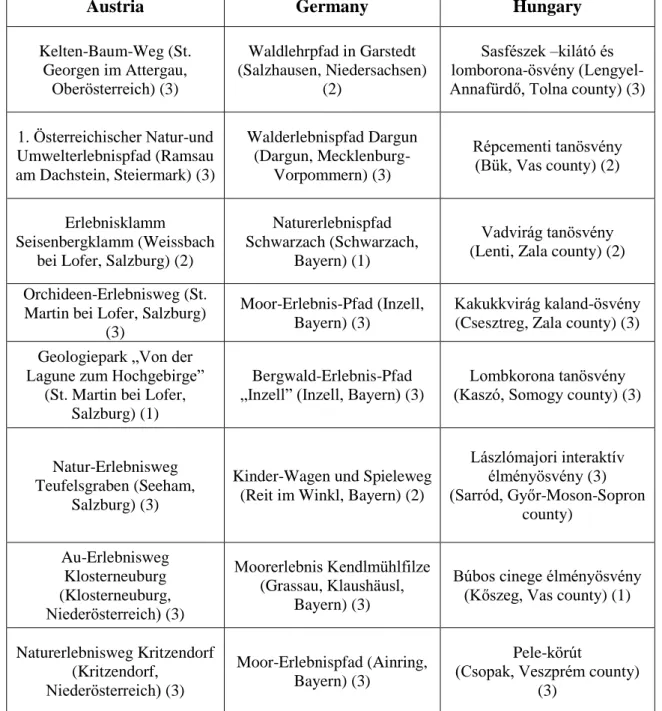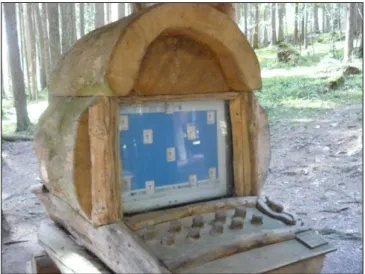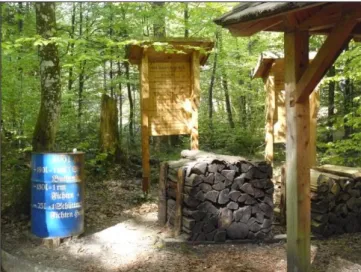DOI:10.17165/TP.2019.1.15
T
ÍMEAK
OLLARICS1Environmental Pedagogical Aspects of Nature Experience Trails – an International Comparative Study
2The development of nature experience trails is closely linked to nature trails. Over the past decades, nature trails have undergone significant changes. The German-speaking countries (Germany, Switzerland, Austria) played an important role in the development of nature experience trails. To explore the environmental pedagogical aspects of these establishments, we need to be familiar with the development process of nature experience trails, the changes in the concepts, the necessary criteria and clarify the numerous related concept (natural experience, environmental education). The study presents the environmental pedagogical aspects of nature experience trails based on German-language literature. It also delineates the results of an international research concerning the environmental pedagogical aspects, the objective of which is a comparative study on nature experience trails in Austria, Germany and Hungary with the development of an objective evaluation system.
1. Introduction
The creation of nature experience trails is linked to nature trails; therefore, we must be familiar with the development history of nature trails. The German-speaking countries (Germany, Switzerland, Austria) played a significant role in the development of nature experience trails.
In Germany, after the appearance of nature trails in the 1930s, several decades passed when they began to recognize (1970s) that the static information transfer did not achieve the desired success in learning and awareness-raising effect (Ebers – Laux – Kochanek, 1998).
After the evolutionary concepts of learning trail, natural experience, second-generation nature trail, discovery trail and thematic path, the first definition of nature experience trail was published in 1994 (Oelsner – Rosemann, 2011; Janssen – Lottmann – Rump, 1994;
Lehnes – Zányi, 2006), and then the first nature experience trail was created in the Bavarian Forest (Eder – Arnberger, 2007), which was one of our research sites.
1 PhD., senior lecturer, University of Sopron, Benedek Elek Faculty of Pedagogy; kollarics.timea@uni- sopron.hu
2 „ SUPPORTED BY THE ÚNKP-17-4-I NEW NATIONAL EXCELLENCE PROGRAM OF THE MINISTRY OF HUMAN CAPACITIES”
The concept of nature experience trail was introduced in Austria also in the 1990s and as per the literature, the first nature experience trail was opened in 1997 in Kals am Grosslockner (Eder – Arnberger, 2007), however, another establishment bears the title for the first nature experience trail as well, which was established in 1991 near Ramsau am Dachstein.
In Switzerland, nature trails appeared in the 1970s (Schärer, 2011; Zimmerli, 1980). For the time being, development of nature experience trails is little known as per the available literature, however, our present research did not cover the study of Swiss nature experience trails.
Nature experience trails appeared later in Hungary than in Germany and Austria, and there is no uniform regulation and criteria concerning naming and design.
2. Theoretical background: definition of nature experience trail
According to the first German-language definition, nature experience trail is a set of stations in the landscape that are related to the environment where they were designed (Janssen – Lottmann – Rump, 1994). Its purpose is information transfer and increasing susceptibility to the environment (sensitization). According to Lottmann, information transfer or sensitization should be interesting, moreover visitors should be actively involved. In addition, all nature experience trails must have a main thread (main theme), and design and implementation must be consistent, following a schema (Janssen – Lottmann – Rump, 1994).
Ebers distinguishes three terms: ’sensory’ trail (Sinnespfad), interactive trail (Interactiver Pfad) and nature experience trail (Naturerlebnispfad). The nature experience trail in his definition is a combination of sensory trail and knowledge transfer with the help of boards or tour guides (Ebers – Laux – Kochanek, 1998).
Megerle created the following definition in 2003: ’nature experience trail is a medium of environmental education that transmits natural experiences through the involvement of different sensory organs and the interactive involvement of visitors’ (Megerle, 2003, p. 8). In her definition, Megerle sets as a criterion that at least three quarters of the stations should activate the visitors and involve their senses. In this approach, therefore, knowledge transfer or transfer of information is not necessarily required, i.e. a sensory trail can also be a nature experience trails according to her definition (Megerle, 2003).
According to Eder and Arnberger, the experience and educational functions of nature experience trails are also emphasized. The interactive and sensory elements allow visitors to
the stops should be interactive and sensory to be able to call the establishment a nature experience trail (Eder – Arnberger, 2007). It can be seen from the above definitions that the concept of nature experience trail is not uniform in German-language literature.
3. Environmental pedagogical aspects of nature experience trails
From the international and Hungarian literature, we know that environmental education contributes to the development of environmentally conscious behavior (Palmer – Neal, 2002;
Havas – Gulyás, 1998; Gulyás, 1998; Havas, 1999). It affects consciousness with knowledge, emotions with experiences and will with purposeful activity (Lehoczky, 1999). In case of nature trails and nature experience trails, the requirements of environmental education and awareness, environmental pedagogy (Lükő, 2003; Kováts-Németh, 2010) and sustainability pedagogy (Havas-Varga, 2006) are non-dispensable.
According to Janssen (1988), the natural experience (Naturerleben) is the emotional center of environmental awareness and the development of action skills. According to his model, the emotional base is expanded by describing, explaining and understanding nature (level of facts), and then we get to environmental consciousness (level of consciousness) and action (level of action) (Ebers – Laux – Kochanek, 1998). Janssen considers it necessary for the nature experience trails to be sensitizing towards nature and the environment, at the same time be able to entertain (Janssen – Lottmann – Rump, 1994). According to Megerle, the activation of visitors and the involvement of sensory organs are important criteria for nature experience trails (Megerle, 2003). A nature experience trail ’must convey natural experiences and therefore directly or indirectly also serve environmental education’ (Megerle, 2003, p.
11.). According to Killermann (2000), holistic environmental education must involve affective, cognitive and motor skills (Eder – Arnberger, 2007). Thus nature experience trail must also realize holistic environmental education, i.e. it must inform, motivate its own activities, stimulate thinking, awaken the gaming instinct and allow sensation by all senses, all through interactive and sensory elements (Eder – Arnberger, 2007). Eder and Arnberger have also sorted nature trails into groups based on environmental pedagogical requirements, where each nature trail type can be assigned to an environmental pedagogical concept (Table 1).
Environmental pedagogical concept Nature trail type
Receptive knowledge transfer Classical (board) nature trail Action-oriented knowledge transfer Interactive trail
Perception of nature Sensory trail
Holistic environmental education,
sustainable environmental education Nature experience trail Table 1. Nature trail types of environmental education concepts
Source: Eder – Arnberger (2007): Lehrpfade. Natur und Kultur auf dem Weg.p. 48. (translation of the author)
4. International comparative study of nature experience trails
The purpose of the international study was to explore German, Austrian and Hungarian nature experience trails, create their literary basis, explore their development features and appearance, perform observations during field visits and develop an evaluation system for the examined nature experience trails. After the development of the evaluation criteria, the aim was the complex evaluation of the visited nature experience trails, particularly focusing on environmental pedagogical aspects.
During the analysis, firstly the German-language literature was examined and then using the method of content analysis on the basis of literature criteria, the nature experience trails to be examined were selected.
The evaluation criteria were developed on the basis of the literature (Ebers-Laux- Kochanek, 1998; Megerle, 2003; Eder-Arnberger, 2007; Kiss ed. 2007; Kollarics, 2015) and first field experiences. When determining the criteria, first the basic and identifying data of the establishment were defined (opening date, founder/conservator, location, environment, type, number of stops, departure board, route type, knowledge to be presented). After the basic data, the characteristics of the information transfer are shown (methods and tools of information transfer, interactivity, involvement of sensory organs, knowledge transfer, relation to the location). These characteristics were followed by design-methodology, ecotourism and marketing features (target group, family friendliness, material usage, route design, discoverability, availability of signs, logo, infrastructure equipment, related services and tourism services, accessibility for people with reduced mobility, general accessibility, opening hours, entry fee, vandalism, marketing, quality assurance, cooperations). The
nature experience trails as a whole (emotional, intellectual, willful components, information transmission means, wording, knowledge transfer, nature and contents of interactive and sensory stops, taking into account the characteristics of the target group).
Theoretical foundations were followed by field surveys in the three mentioned countries, supported by photographic evidence for each nature experience trail. During the field survey, fifteen German, fifteen Austrian and fifteen Hungarian nature experience trails were assessed (Table 2). In Hungary, the selection of nature experience trails was more difficult than in the German-speaking countries as the nature experience trail name is used only by a few establishments, so we needed to find such nature trails that, based on the descriptions, could have interactive and sensory elements as well, fulfilling the criteria of nature experience trails.
Among the possible sites were nature trails, circuit trails, eco parks, fairy tale paths and canopy trails.
Austria Germany Hungary
Bienenerlebnisweg (Zwettl an der Rodl,Oberösterreich) (2)
Naturerlebnispfad Bayerischer Wald (Spiegelau,
Bayern) (3)
Budakeszi Vadaspark vadászati tanösvénye (Budakeszi, Pest county) (3)
Mühlviertler Vogelkundeweg (Gutau,Oberösterreich) (3)
Naturerlebnispfad Oberhof (Oberhof, Thüringen) (2)
Pandúr Ökopark élményösvénye (Baja, Bács-
Kiskun county) (3) Waldlehrpfad „Wald erleben,
Natur begreifen” (Linz- Elmberg,Oberösterreich) (2)
Heide-Erlebnispfad (Schillohsberg, Niedersachsen) (3)
Mimó és Csipek érzékek ösvénye (Ferenc-hegy, Budapest, Pest county) (2) Naturerlebnisweg Steinerne
Mühl (Haslach an der Mühl, Oberösterreich) (3)
Fluss-Wald-Erlebnispfad (Müden Örtze, Niedersachsen) (2)
Mimó és Csipek meseösvény (Kis-Sváb-hegy, Budapest,
Pest county) (2) Lehrobstwiese
Unterkagererhof (Unterkagererhof, Oberösterreich) (1)
Heide-Erlebnispfad (Neuenkirchen, Niedersachsen) (3)
Csiga-túra tanösvény (Zalakaros, Zala county) (3)
Weg der Sinne (Haag am Hausruck, Oberösterreich) (3)
Märchenwanderweg „der Trickser” (Jesteburg,
Niedersachsen) (1)
Éger-ösvény (Zalakaros, Zala county) (3)
Erlebnisweg Wald der Kinder (Zell am Pettenfirst,
Oberösterreich) (3)
Erlebnispfad Amelinghausen (Lopausee in Amelinghausen,
Niedersachsen) (2)
Tamási-Miklósvári tanösvény (Tamási, Tolna county) (2)
Austria Germany Hungary
Kelten-Baum-Weg (St.
Georgen im Attergau, Oberösterreich) (3)
Waldlehrpfad in Garstedt (Salzhausen, Niedersachsen)
(2)
Sasfészek –kilátó és lomborona-ösvény (Lengyel- Annafürdő, Tolna county) (3) 1. Österreichischer Natur-und
Umwelterlebnispfad (Ramsau am Dachstein, Steiermark) (3)
Walderlebnispfad Dargun (Dargun, Mecklenburg-
Vorpommern) (3)
Répcementi tanösvény (Bük, Vas county) (2)
Erlebnisklamm Seisenbergklamm (Weissbach
bei Lofer, Salzburg) (2)
Naturerlebnispfad Schwarzach (Schwarzach,
Bayern) (1)
Vadvirág tanösvény (Lenti, Zala county) (2) Orchideen-Erlebnisweg (St.
Martin bei Lofer, Salzburg) (3)
Moor-Erlebnis-Pfad (Inzell, Bayern) (3)
Kakukkvirág kaland-ösvény (Csesztreg, Zala county) (3) Geologiepark „Von der
Lagune zum Hochgebirge”
(St. Martin bei Lofer, Salzburg) (1)
Bergwald-Erlebnis-Pfad
„Inzell” (Inzell, Bayern) (3)
Lombkorona tanösvény (Kaszó, Somogy county) (3)
Natur-Erlebnisweg Teufelsgraben (Seeham,
Salzburg) (3)
Kinder-Wagen und Spieleweg (Reit im Winkl, Bayern) (2)
Lászlómajori interaktív élményösvény (3) (Sarród, Győr-Moson-Sopron
county) Au-Erlebnisweg
Klosterneuburg (Klosterneuburg, Niederösterreich) (3)
Moorerlebnis Kendlmühlfilze (Grassau, Klaushäusl,
Bayern) (3)
Búbos cinege élményösvény (Kőszeg, Vas county) (1)
Naturerlebnisweg Kritzendorf (Kritzendorf,
Niederösterreich) (3)
Moor-Erlebnispfad (Ainring, Bayern) (3)
Pele-körút
(Csopak, Veszprém county) (3)
Table 2. The nature experience trails and nature trails assessed during the research and their environmental pedagogical evaluation
Summarizing the above-mentioned environmental pedagogical aspects (emotional, intellectual, willful components, means of information transmission, wording, knowledge transfer, nature and contents of interactive and sensory stations, taking into account the characteristics of the target group), in case of all nature experience trails, we classified the assessed trails into three categories: establishment implementing environmental pedagogical aspects only marginally (1), partially (2), or wholly (exemplary) (3).
The results are also shown in Table 2. It can be seen that in Austria, ten of the assessed trails were considered to be exemplary of environmental pedagogical consideration, in
Germany eight, while in Hungary nine nature experience trails (nature trails) were given the same assessment. It is important to note that meeting the literature criteria of the definition of nature experience trail generally (but not always!) entails that the establishment is also outstanding from an environmental pedagogical point of view (through the combination of active involvement of sensory organs, knowledge transfer and interactivity). However, the fulfillment of environmental pedagogical aspects does not necessarily mean that the given establishment can only be a nature experience trail. This is how some of the Hungarian nature trails have been rated 3 (eg. characteristics suitable for target groups, wording, knowledge transfer and the consideration of emotional, intellectual and willful components, despite the presence of only a few sensory elements).
Many of the assessed nature experience trails can be considered as exemplary good practice, but from an environmental pedagogical point of view, the Austrian „1.
Österreichischer Natur-und Umwelterlebnispfad”, and the German Bergwald-Erlebnis-Pfad
„Inzell” nature experience trails can be highlighted as examples to be followed (Figures 1 and 2 show stops of the nature experience trails).
Figure 1. Forest computer in the ’research station’
(1. Österreichischer Natur-und Umwelterlebnispfad)
Figure 2. ’From wood to timber’ sto (Bergwald-Erlebnis-Pfad „Inzell”)
5. Summary
Nature experience trails emerged through the development of nature trails, the German- speaking countries played a prominent role in the theoretical foundation and practical implementation. During the international comparative research on nature experience trails, we studied the German-language literature and assessed German, Austrian and Hungarian nature experience trails. With the help of the literature and field visits we have developed an objective evaluation system in which we also examined the realization of environmental pedagogical aspects. In all three countries, the research found that the environmental pedagogical aspects are partially or fully implemented in case of the surveyed nature experience trails.
BIBLIOGRAPHY
Ebers, S. − Laux, L. − Kochanek, H-M. (1998). Vom Lehrpfad zum Erlebnispfad: Handbuch für Naturerlebnispfade. Wetzlar: NZH Verlag.
Eder, R. − Arnberger, A. (2007). Lehrpfade-Natur und Kultur auf dem Weg: Lehrpfade, Erlebnis-und Themenwege in Österreich. Wien: Böhlau Verlag.
Gulyás, P. (1998). A környezeti nevelés célja, követelményrendszere. In: Gulyás P. (Ed.), A környezetvédelmi oktatási szakértői tevékenység elméleti és gyakorlati megalapozása, (pp 50 − 55). Budapest: Természet- és Környezetvédő Tanárok Egyesülete.
Havas, P. – Gulyás P. (1998). Értékek és alapelvek. In: Vásárhelyi T. – Victor A.(Ed.), Nemzeti Környezeti Nevelési Stratégia: alapvetés, (pp 1 – 16). Budapest: Magyar
Havas, P. (1999). A környezeti nevelés néhány pedagógiai elve és területei. In: A környezetpedagógia időszerű kérdései: válogatott írások: oktatási segédanyag, (pp. 30 – 42). Eger: EKF Líceum Kiadó.
Havas, P. – Varga A. (2006). A környezeti neveléstől a fenntarthatóság pedagógiai gyakorlata felé. In: Varga A. (Ed.), Tanulás a fenntarthatóságért, (pp. 49–72). Budapest: Országos Közoktatási Intézet.
Janssen, J. − Lottmann, R. − Rump, C. (1994). Erlebnispfade statt Lehrpfade. Seminarbericht.
Gut Sunder, Winsen.
Kiss, G. (Ed.). (2007). Tanösvények tervezése: módszertani útmutató. Eger: Bükki Nemzeti Park Igazgatóság.
Kollarics, T. (2015). A tanösvények szerepe a környezeti szemléletformálásban – tervezés, hatékonyságvizsgálat és módszertani vonatkozások [Doktori disszertáció]. Nyugat- Magyarországi Egyetem, Sopron.
Kováts-Németh, M. (2010). Az erdőpedagógiától a környezetpedagógiáig. Pécs: Comenius Kiadó.
Lehnes, P. − Zányi, E. (2006). Lehr-, Erlebnis- und Themenpfade: Handbuch. Naturpark Südschwarzwald.
Lehoczky, J. (1999). Iskola a természetben avagy A környezeti nevelés gyakorlata. Budapest:
Raabe Klett Könyvkiadó Kft.
Lükő, I. (2003). Környezetpedagógia: bevezetés a környezeti nevelés és oktatás pedagógiai és társadalmi kérdéseibe. Budapest: Nemzeti Tankönyvkiadó.
Megerle, H. (2003). Naturerlebnispfade – neuen Medien der Umweltbildung und des Landschaftsbezogenen Tourismus? Bestandsanalyse, Evaluation und Entwicklung von Qualitätsstandards. Tübingen: Geographisches Institut der Universität Tübingen.
Oelsner, G. − Rosemann, D. (2011). Lehrpfade und Lehrgärten: Arbeitsmaterialie Agenda- Büro Nr. 47. Karlsruhe: LUBW Landesanstalt für Umwelt, Messungen und Naturschutz Baden-Württemberg.
Palmer, J. – Neal, P. (2002). A környezeti nevelés kézikönyve. Budapest: Körlánc Egyesület.
Schärer, R. (2011). Theorie der Erlebnispfade. [online]. In: Roger Schärer honlapja, Zürich.
http://www.uru.ch/blog/2011/07/30/theorie-der-erlebnispfade/ [20th July 2013.]
Zimmerli, E. (1980). Freilandlabor Natur: Schulreservat, Schulweiher, Naturlehrpfad.
Schaffung, Betreuung, Einsatz im Unterricht. Schweizerisches Zentrum für Umwelterziehung. Zürich: WWF Schweiz.


